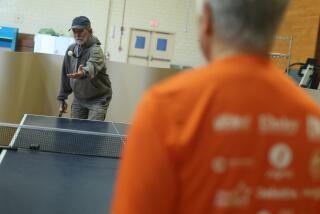Edwin S. Shneidman dies at 91; pioneer in the field of suicide prevention
- Share via
Edwin S. Shneidman, a pioneer in the field of suicide prevention and a prolific thinker and writer who believed that life is enriched by contemplation of death and dying, has died. He was 91.
He died Friday afternoon at his home in West Los Angeles, according to his son, Robert. He had been in poor health for the last few months.
Shneidman, one of the founders of the Los Angeles Suicide Prevention Center, believed that two simple questions -- “Where do you hurt?” and “How may I help you?” -- could begin to unlock the suicidal impulse.
Shneidman, along with Norman Farberow and Robert Litman, established the center in an abandoned tuberculosis hospital on the grounds of Los Angeles County Hospital in 1958. Staff members offered counseling and support over the phone to the depressed and suicidal. It represented a radical idea in mental health care in America.
Research into suicide -- and suicide itself -- was largely shunned and stigmatized. In time, the Suicide Prevention Center captured the popular imagination in movies and books and became a national center for studying the enigma of suicide.
Shneidman viewed suicide as a psychological crisis and -- as did Albert Camus -- as the “one truly serious philosophical problem.”
“Suicide is a complex malaise,” Shneidman said. “Sociologists have shown that suicide rates vary with factors like war and unemployment; psychoanalysts argue that it is rage toward a loved one that is directed inward; psychiatrists see it as a biochemical imbalance. No one approach holds the answer: It’s all that and more.”
The son of Russian Jewish immigrants, Shneidman was born in York, Pa., in 1918. He grew up in Lincoln Heights, where his father owned a department store at Broadway and Griffin Avenue.
He attended UCLA and in 1940 earned a master’s degree in psychology. After serving in the Army during World War II, he received a doctorate in clinical psychology from USC and studied schizophrenia as an intern at the VA hospital in Brentwood.
One morning in 1949, he was asked by the director to write letters of condolence to the widows of two young veterans, one who had hanged himself and one who had shot himself. Suicide, as a clinical study, had never interested Shneidman, but he decided to research the two cases.
At the coroner’s office in downtown Los Angeles, a clerk directed him to the ledgers of the city’s dead, housed in a subterranean vault filled with dust and the smell of motor oil. What was supposed to be a two-hour visit turned into a daylong affair.
The study of suicide and the more radical proposition that it could be prevented became his life’s passion. “No one has to die,” he was fond of saying. “It is the one thing that will be done for you.”
Starting in 1955, Shneidman played a major role in funding the work of the Suicide Prevention Center with grants from the National Institute of Mental Health. Most famously, the center helped the city coroner determine that the death of Marilyn Monroe in 1962 was suicide. Its methodology was the psychological autopsy, an interview method developed by Shneidman, Farberow and Litman.
Shneidman left the center in 1966 and organized a national suicide prevention project that in three years saw the number of prevention centers in the country grow from 15 to more than 100. He also founded the American Assn. of Suicidology, the first professional organization devoted to the study of suicide.
In 1970 he became a professor of thanatology at UCLA. By 1972, federal grants for suicide prevention and its study had ebbed, and Shneidman’s national prevention project was shut down. His theories, which focused upon the psychological and sociological causes of suicide, were an increasingly difficult sell in an era of budget cuts, pharmaceutical interventions and neurological research.
In later years, the Suicide Prevention Center, which received its funding from the city of Los Angeles, was nearly shut down before being incorporated into programs offered at the Didi Hirsch Community Mental Health Center.
Shneidman, however, was undeterred. An indefatigable writer, the author of 20 books, including the 1973 work “Deaths of Man,” which was nominated for a National Book Award, he avidly advanced his own theories and perceptions about suicide, disarming most critics with wit, understatement and considerable knowledge.
“You don’t understand psychopathic murder by slicing [Jeffrey] Dahmer’s brain, and you won’t get E=MC2 by slicing Einstein’s brain,” he says. “Unfortunately, it’s in the mind. And the mind is not a structure. It is an ephemeral concept.”
He edited a dozen books and was the founding editor of the quarterly journal Suicide and Life-Threatening Behavior. In 1987 he received the American Psychological Assn. Award for Distinguished Contributions to Public Service.
Slowed by diabetes, cancer and congestive heart failure, Shneidman spent his last years receiving guests at his home in West Los Angeles.
Flattered by the attention, Shneidman nonetheless stayed devoted to suicide and the works of Herman Melville. The two, he argued, are more compatible than you may think. “Moby-Dick” is all about suicide, he often announced, as he read its first paragraph:
“Whenever I find myself growing grim about the mouth; whenever it is a damp, drizzly November in my soul . . . I account it high time to get to the sea as soon as possible. This is my substitute for pistol and ball. . . . “
Shneidman is survived by four sons, David, Jonathan, Paul and Robert, and six grandchildren.
thomas.curwen@latimes.com
More to Read
Start your day right
Sign up for Essential California for the L.A. Times biggest news, features and recommendations in your inbox six days a week.
You may occasionally receive promotional content from the Los Angeles Times.







